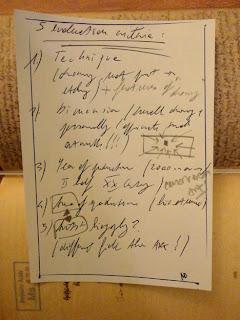 |
| Notes on the five criteria from The Drawing Archive. |
The five individual criteria in alphabetic order:
Manca Bajec:
1. Aesthetic quality of the work.
2. Contemporary (i agree that it would be interesting to find an artist that would either hold merit or someone on the rise).
3. Size – ( although i generally would not mind a larger work, perhaps in our case a smaller work would be more interesting to our concept).
4. Preference of technique- Since I believe etching is a drawing technique, I would not mind it but I would find it more challenging to find something that is truly a drawing in the most basic sense- pencil, ink, charcoal...
5. The concept behind the work or the work of the artist in general...here I agree with both of you...it would be interesting to find someone that fits our profile either personally or in the work itself.
Milia Xin Bi:
1. Contemporary: I think it is interesting that we are researching the potential value of contemporary drawing. We are living in the contemporary, and we are creating the value of the art in our age.
2. Relational: It will be great if our selected drawing strongly related to our curating context.
3. Aesthetics: Definitely high quality piece of art.
4. Materials: I think it’s a part of ‘contemporary’, isn’t it? Drawing is changing all the time because of the different of materials.
5. Size: I don’t mind the size, but I think it is better to have a good frame.
Michele Drascek:
1. Technique (drawing, not print nor etching / at least an artwork produced within the framework "drawing", so that contains the peculiar features of the technique of drawing).
2. Dimension (since the original idea is to exhibit a small drawing + personally I appreciate small artworks in general).
3. Year of production (if we want to stick to the contemporary I would not go back to the year 2000 / if we want to widening the possibilities at least the second half of the XX century).
4. Area of production (could be challenging to find a drawing of an artist simply reachable for a meeting, an interview or writing in support of the project).
5. Artist biography (could be better an artist that comes from a different field of knowledge, so to be more suitable to the drawing project as a whole).
Emma Moore:
1. Unfinished (I like work when the thought process and a sense of "figuring out" is evident, I think that would suit our overall idea)
2. Good/Strong quality of line
3. Contemporary ( Ideally I would like work from an established artist that would be able to hold its own in the space as the only artwork)
4. Experimental in the use of materials (I've been thinking about what constitutes a drawing and I think something that challenges the idea of what a drawing is might be interesting)
5. Dimension (I also agree that it should be small)
The fact that we want to purchase an artwork is making us a "collective collector", as stressed in the concept of project. Questioning the purpose and meaning of being a collector is one of our commitment. As the New York art adviser Allan Schwartzman say:
ReplyDelete"For all kinds of art collectors the most important things to ask yourself are: why do you want to collect art and what do you hope to achieve by ding so? Understand a little bit about what are you doing before you do it. At the same time, you can't over-analyse; you are never going to know everything, so sometimes you just have to jump in and make a decision and go with it".
The drawing collective is more concentrate in understand meanings and be consciously involved in processes than "jump in". But, sometimes, also that is part of the game.
Michele Drascek